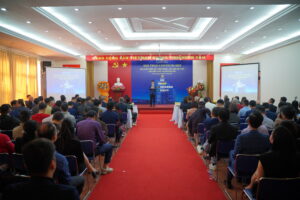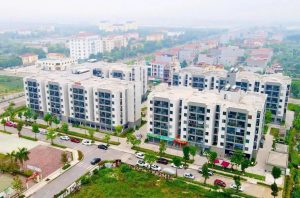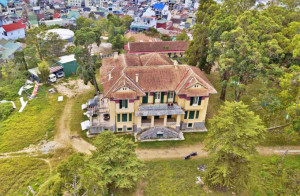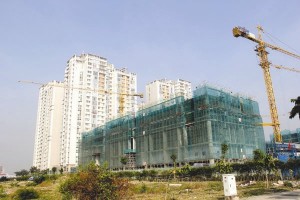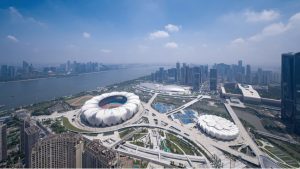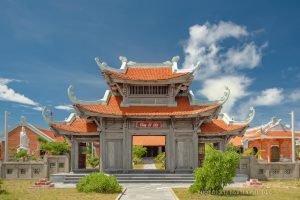Công bố quốc tế trong lĩnh vực kiến trúc, xây dựng (Tuần 3 tháng 10-2021)
Trong số này chúng tôi xin giới thiệu tới quý độc giả những nội dung chính của các công bố quốc tế đăng tải trên ScienceDirect và Springer Nature do Cục Thông tin khoa học và công nghệ quốc gia (NASATI) mua quyền truy cập như sau:
Quy hoạch đô thị:
– Đô thị hóa định hình việc sử dụng đất nông nghiệp như thế nào? Làm sáng tỏ mối liên hệ giữa việc bỏ hoang đất nông nghiệp và đô thị hóa ở Trung Quốc
– Khung hỗ trợ quyết định đa mục tiêu để ưu tiên các vị trí trồng cây trong đô thị
– Xây dựng không gian công cộng an toàn hơn: Khám phá sự khác biệt về giới trong nhận thức về an toàn trong không gian công cộng thông qua các can thiệp thiết kế đô thị
– Bản đồ độ phân giải cao của khu vực tầng đô thị của Trung Quốc đại lục
– Hiệu ứng phục hồi tiềm năng của cảnh quan âm thanh đô thị: Đặc điểm tính cách, tính khí và nhận thức về môi trường đô thị VR
– Đô thị xanh: Cơ sở cấu trúc và chức năng thần kinh của đô thị và không gian xanh trong khu phố của người lớn tuổi
– Ước tính tính phù hợp của nước ngầm nhằm cung cấp nước uống bền vững và sản xuất thực phẩm ở một khu vực bán đô thị phía nam Ấn Độ: Tập trung đặc biệt vào đánh giá rủi ro để xây dựng xã hội lành mạnh
– Ảnh hưởng của hiệu quả làm mát của các vùng đất ngập nước đô thị trong một siêu đô thị nội địa: Một nghiên cứu điển hình ở Thành Đô, Tây Nam Trung Quốc
– COVID-19 và không gian đô thị: Một cách tiếp cận tích hợp mới theo CFD cho các cơ hội sức khỏe cộng đồng
Khoa học và công nghệ trong lĩnh vực kiến trúc, xây dựng:
– Thí nghiệm hiện trường và khảo sát số liệu về môi trường nhiệt của đường hầm có kết cấu lớp không khí
– Đánh giá so sánh tính bền vững của hai vật liệu xây dựng làm từ gỗ được thiết kế: Phân tích vòng đời của CLT so với GLT
– Lập bản đồ nghiên cứu khoa học về đánh giá vòng đời trong ngành xây dựng: Phân tích khoa học
– Hiệu quả ngăn chặn bụi và làm mát của hệ thống phun được lắp đặt giữa các giá đỡ thủy lực trong mặt khai thác than được cơ giới hóa hoàn toàn
– Ảnh hưởng của khối lượng nhiệt, thông gió ban đêm và che nắng cho cửa sổ đối với sự thoải mái nhiệt vào mùa hè của các tòa nhà ở khí hậu ôn hòa
– Định lượng các hiệu ứng dạng tòa nhà 3D đối với nhiệt độ bề mặt đất đô thị và mô hình hóa các mô hình tương quan theo mùa
– Đánh giá vòng đời của bốn tòa nhà ở Greenland
– Hệ số thiết kế địa chấn và hệ số đối với tường chịu cắt tấm composite ghép nối / bê tông đổ đầy (CC-PSW / CF)
– Phản ứng địa chấn của khung đỡ cọc bằng cách sử dụng kết hợp phương pháp tiếp cận độ cứng động và phương pháp của Galerkin
– Bộ giảm chấn hỗn hợp tự định tâm để cải thiện khả năng phục hồi địa chấn
Vật liệu xây dựng:
– Tự động phát hiện và phân đoạn các lỗ rỗng bê tông bằng cách sử dụng “nguồn sáng góc 0 độ” và học sâu
– Tổng hợp và đánh giá một loại xi măng giếng dầu mới làm chậm chịu nhiệt độ
– Ảnh hưởng của việc biến đổi ma trận và lai sợi đến hiệu suất cơ học còn lại ở nhiệt độ cao của vật liệu tổng hợp gốc xi măng tăng cứng biến dạng
– Nghiên cứu số lượng và thực nghiệm về ảnh hưởng của lượng mưa đến hành vi vận chuyển của các ion clorua trong bê tông
– Ảnh hưởng của thân cây bông nano và tro lá cọ đến các đặc tính của bê tông hiệu suất cao kết hợp cốt liệu bê tông tái chế
– Phân tích lý thuyết về động học hút nước của cốt liệu tái chế ngâm trong nước
– Nghiên cứu hành vi cháy và nhiệt của các tấm mặt tiền làm bằng vật liệu tổng hợp gốc xi măng cốt sợi tự nhiên
– Mô hình thấm kép của các mối nối bê tông
– Phân tích hành vi di chuyển của hệ thống cấp phối-bê tông nhựa dựa trên hiệu ứng bề mặt của các hạt
– Các tính chất cơ học, vật lý và cấu trúc vi mô của vữa có chất kết dính chất thải nhựa nóng chảy
Xin trân trọng giới thiệu!
QUY HOẠCH ĐÔ THỊ
- Local habitat factors and spatial connectivity jointly shape an urban insect community
Landscape and Urban Planning, Volume 214, October 2021, 104177
Abstract
As the world becomes more and more urbanized, it is increasingly important to understand the impacts of urban landscapes on biodiversity. Urbanization can change local habitat factors and decrease connectivity among local habitats, with major impacts on the structure of natural food webs. However, most studies have focused on single species, or compared rural to urban habitats, which do not inform us on how to design and manage cities to optimize biodiversity. To understand the local and spatial drivers of ecological communities within urban landscapes, we assessed the relative impact of local habitat factors (sunlight exposure and leaf litter) and spatial connectivity on an oak-associated herbivore community within an urban landscape. From the local habitat factors, leaf litter but not sunlight exposure was related to herbivore species richness, with leaf litter contributing to the maintenance of high species richness on isolated trees. Guilds and species differed strongly in their response to local habitat factors and connectivity, resulting in predictable variation in insect community composition among urban oaks. Taken together, our study shows an interactive effect of local and spatial factors on species richness and species composition within an urban context, with guild- and species-specific life histories determining the response of insects to urban landscapes. To maintain biodiversity in the urban landscape, preserving a dense network of local habitats is essential. Moreover, allowing leaf litter to accumulate can be a simple, cost-effective conservation management practice.
- How is urbanization shaping agricultural land-use? Unraveling the nexus between farmland abandonment and urbanization in China
Landscape and Urban Planning, Volume 214, October 2021, 104170
Abstract
Urbanization often results in agricultural expansion but can also lead to farmland abandonment. However, it remains unclear about the extent, exact timing and determinants of farmland abandonment in response to ongoing urbanization. Using the example of China’s Sunan economic region, we present the spatiotemporal trajectories of farmland abandonment and recultivation from 2001 to 2018. We classified Landsat satellite image time-series with a regression trees classifier in Google Earth Engine (GEE). Further, we analyzed the spatiotemporal patterns and rates of farmland abandonment and recultivation. Spatially-explicit logistic regressions were applied to explore the determinants of farmland abandonment in space and time. Our results show widespread farmland abandonment: approximately 232,700 ha of farmland had ever been abandoned from 2001 to 2018, with the highest annual abandonment rate (8.5%) in 2017. Approximately 66,200 ha of abandoned fields were later recultivated, with the maximum recultivated area (13,600 ha) in 2018. Approximately 92% of abandoned fields were later recultivated or reused as the impervious surface within two years of the first detection of abandonment, suggesting more rapid land transformation. The regressions reveal that locational and socio-economic factors determined farmland abandonment patterns. Specifically, a higher likelihood of farmland abandonment was statistically associated with an increased distance from the nearest settlements; the significantly positive relationship between ‘Non-agricultural GDP’ and farmland abandonment strengthened over time. In contrast, a lower likelihood of farmland abandonment was observed in areas with more cash crops. The statistical results may extend the application of the Ricardian comparative advantage theory along with Alonso’s bid rent theory to explain and predict abandonment patterns in response to ongoing urbanization. Our study is the first attempt in China to apply 30-m Landsat imageries to reconstruct abandonment patterns over long time-series. The findings provide important insights into adjusting land-management practices for preventing farmland abandonment due to urbanization.
- A multi-objective decision support framework to prioritize tree planting locations in urban areas
Landscape and Urban Planning, Volume 214, October 2021, 104172
Abstract
With tree planting initiatives being undertaken in different cities, careful thought needs to be put into the placement of trees, the beneficiaries of ecosystem services from these trees, and the potential impacts of alternative tree planting schemes. Using a spatially explicit methodology within biophysical ecosystem service models, this research develops a multi-objective decision support framework to guide future greening initiatives towards prioritizing planting locations that maximize multiple objectives. In a case study application of the framework in the Bronx, NY, the analysis utilizes spatially distributed census block group data and linear programming, a mathematical optimization technique, to identify optimal and equitable planting locations considering increases in tree cover, monetary benefits from avoided runoff, PM2.5 air pollutant removal and heat index reduction as well as tree planting costs and the equality and equity of urban tree ecosystem services. Using different optimization scenarios, the framework identifies optimal planting schemes by minimizing planting costs, maximizing increases in tree cover and ecosystem service benefits, and the equity of canopy cover and ecosystem services, arriving at a wide range of different planting recommendations. We conclude that multi-objective prioritization frameworks can identify optimal locations for greater total benefits from urban greening and that the proposed framework has the potential to inform decision making in different cities.
- Building safer public spaces: Exploring gender difference in the perception of safety in public space through urban design interventions
Landscape and Urban Planning, Volume 214, October 2021, 104180
Abstract
Concern around personal safety is a significant factor in constraining women’s access to and use of public space. One strategy presented to address this involves altering the design of built environments. However, tension and controversy surround these arguments in the literature on safety perception in public space. This study seeks to explore whether the presence of three design interventions commonly cited in the literature act to enhance or reduce perceptions of safety in public space, focusing on women’s experiences in particular. Three design interventions are examined: public toilets, solid walls, and graffiti removal. To test these interventions, an image-based randomised control trial with 104 participants was conducted in 2018 in London (UK). A series of control and treatment images simulating each design intervention was viewed and ranked by participants according to perceived safety. The findings of this study suggest that: the presence of public toilets does not affect perceived safety; eliminating graffiti has a weak significant impact on perceived safety; and removing solid walls leads to significant improvements of perceptions of safety, with the effect being stronger for women. These results suggest that to maximise investment effectiveness, urban design and planning policies that aim to increase perceptions of safety should be evidence-based, and need to integrate a gendered perspective. The presented technique could support urban design processes by examining the safety-enhancement impact of proposed public space interventions prior to their being rolled out.
- High-resolution mapping of mainland China’s urban floor area
Landscape and Urban Planning, Volume 214, October 2021, 104187
Abstract
Urbanization studies are of global interest and mainly focus on mapping urban areas and areas of expansion using remote sensing data. However, information about the 3-dimensional characteristics or expansion of urban buildings is absent due to difficulties in data acquisition. Quantifying the urban floor area is crucial for assessing urban 3-D morphology. We used a random forest regression model to predict the first urban floor area of mainland China at a 130-m spatial resolution based on high spatial resolution nighttime light LUOJIA 1-01 images (130-m), a population map (100-m), and a single building dataset encompassing 71 cities. The predicted floor area (PFA) map for mainland China was estimated from the single building dataset of 50 cities, and data from the other 21 cities were used to estimate the accuracy. The results showed that the total accuracy of the PFA map is strong (R2 = 0.68, RMSE = 7277.46 m2/ha). The PFA map overestimated the values in low value areas and underestimated the values in high value areas. The accuracy was also acceptable at the single city scale based on the results from six cities (R2 > 0.6). The calculated floor area map for 71 cities was merged with the PFA map by replacing the values in the corresponding locations to generate the final predicted floor area (FPFA) map, which enabled higher accuracy. The total floor area is 76038.39 km2, which is 0.79% of the total area of China. The general distribution of the floor area amount and intensity showed that the coastline had a higher intensity than the inner region of the country and the southern region had a higher intensity than the northern urban area along the coastline. The floor area distribution was extremely uneven among the provinces. The top six provinces represent 50.01% of the total floor area; however, the last six provinces represent only 3.31%. The high spatial resolution FPFA map of mainland China calculated by us has great potential application in urban ecology research, such as the impact of FPFA on heat island and haze.
- Potential restorative effects of urban soundscapes: Personality traits, temperament, and perceptions of VR urban environments
Landscape and Urban Planning, Volume 214, October 2021, 104188
Abstract
This study investigated the potential restorative (PR) effects of urban soundscapes. To establish a new set of PR criteria for urban environments, this study recreated 10 urban sites in virtual reality, instead of using the typical method of questionnaires. A list of restoration-related semantic terms was derived from narrative interviews of 50 subjects who freely expressed their perceptions of the space. PR criteria were determined based on the derived list and two groups were found: the PR group and potential non-restorative group. The objective characteristics of urban soundscapes—acoustic and visual characteristics and characteristics of moving objects—were analyzed. Participants provided their subjective responses regarding sound source identification, perceived affective quality, and overall quality. The Temperament and Character Inventory-Revised-Short Version and Satisfaction with Life Scale were utilized to analyze participants’ individual characteristics. Based on it, a model was developed to predict whether PR criteria could be satisfied, which was 82.6% accurate (85.9% specificity, 71.8% sensitivity). It was determined that the overall level of preference regarding an urban soundscape is a significant factor in satisfying PR criteria. In particular, the design and planning of urban spaces should aim to reduce a space’s loudness and increase the revisitation rate to promote the restoration of the urban residents’ mental health. Furthermore, for individuals, a trait based on acquired experience has a greater impact on the PR effects of urban soundscapes than innate temperament. This study’s findings can serve as supporting data to design sustainable and health-promoting urban soundscapes.
- How perceived sensory dimensions of urban green spaces are associated with teenagers’ perceived restoration, stress, and mental health?
Landscape and Urban Planning, Volume 214, October 2021, 104185
Abstract
Teenagers face unprecedented levels of stress and mental health issues. However, this age group is understudied in terms of which green environments are restorative for them. This study investigates associations between perceived sensory dimensions (PSDs) of urban green spaces (UGSs) and teenagers’ perceived restoration, stress, and mental health. Data were collected through surveys with 384 teenagers ages 13–19 in 2018 in eight different UGSs in Aydın, Turkey. Measures included the PSDs (i.e., nature, serene, space, rich in species, social, prospect, culture, and refuge), the Perceived Restorative Components Scale for children (PRCS-C) (i.e., fascination, being away-physical, compatibility, being away-psychological, and extent), and health indicators (i.e., stress and mental health). Multivariate linear regression and stratified analyses were conducted to examine associations and differences between boys and girls controlling for confounding factors. Regression analyses showed that ‘nature’ was positively associated with teenagers’ perceived restorativeness (i.e., fascination, being away-physical, and extent). Whereas, ‘refuge’ was positively associated with perceived restorativeness (i.e., being away-physical) and negatively associated with teenagers’ stress. The results also showed that while ‘space’ was negatively associated with perceived restorativeness (i.e., fascination), ‘prospect’ was negatively associated with stress and positively associated with mental health. Stratified analyses revealed that ‘nature’ was both positively associated with boys’ perceived restorativeness (i.e., being away-physical) and girls’ perceived restorativeness (i.e., fascination). While ‘space’ was negatively associated with boys’ perceived restorativeness (i.e., fascination), ‘prospect’ was negatively associated with boys’ stress and positively associated with boys’ mental health. The findings also showed that ‘prospect’ and ‘refuge’ were negatively associated with girls’ stress. The findings suggest that providing characteristics of ‘nature’, ‘refuge’, and ‘prospect’ in UGSs may provide restorative effects and mental benefits to teenagers. However, further research is needed before using these characteristics as a tool by landscape architects and city planners.
- The financial impact of street-level greenery on New York commercial buildings
Landscape and Urban Planning, Volume 214, October 2021, 104162
Abstract
Urban street-level greenery is empirically documented to improve mental and physical health, increase productivity, increase urban environmental equality and reduce carbon footprints. In addition, these benefits raise residents’ welfare, which has been correlated with increases in residential house prices. We measure street-level greenness in New York City through a novel Green View Index (GVI) using Google Street View images, and assess the impacts of greenness on commercial real estate prices. Using a sample of office transactions, we spatially correlate Google Street View Images for New York City over the 2010 to 2017 period. We find an 8.9% to 10.5% statistically, economically and positive transaction premium and a 5.6% to 7.8% rent premium for offices with low to high street-level greenness relative to those building transactions spatially correlated with very low greenness. Estimations are robust t with proximity to parks, subway stations, sidewalk widths, household income levels and investments by Building Improvement Districts, as well as other vital and standard office valuation features. By documenting the role of greenery in commercial building valuations, our results give a more complete understanding of the value of greenness in urban environments, as well as the economic role that urban landscape architecture, planning and development has upon cities.
- Building to conserve: Quantifying the outdoor water savings of residential redevelopment in Denver, Colorado
Landscape and Urban Planning, Volume 214, October 2021, 104178
Abstract
Outdoor water use represents up to half of total urban water demand in many semi-arid and arid cities and presents a climate adaptation challenge in urban centers. As indoor efficiency and reuse improves, outdoor use amounts to an increasingly large portion of consumptive urban water demand. Infill development, or the redevelopment of single-family properties to more dense multi-family and mixed-use developments, is a growing trend in urban planning; however, the influences of infill on outdoor water demand are poorly understood. The current work utilizes a remote sensing-based methodology to calculate parcel-scale irrigation rates in Denver, Colorado and applies a novel resampling methodology to model the impacts of redevelopment on outdoor water use. Results for 2018 showed irrigation rates varied by almost 250 mm between park and commercial land uses, and mean single-family irrigation rates of 224 mm exceeded multi-family rates by 70 mm. In the Berkeley neighborhood, modeled redevelopment of 1,347 single-family parcels (39.5%) resulted in a 102,000 m3 (83 acre-feet, or 30.2%) reduction in outdoor use. Citywide analyses indicate reductions of 141,000 m3 (114 acre-feet, or 0.76%) of residential outdoor use per one percent increase in redeveloped single-family parcels. These savings are equivalent to new annual supply for 181 four-person households and may provide significant contributions towards climate adaptation. Results highlight the importance of the continued integration of land use and water supply for demand management within the urban planning process.
- The role of bike sharing stations in the perception of public spaces: A stated preferences analysis
Landscape and Urban Planning, Volume 214, October 2021, 104174
Abstract
The pervasiveness of bike sharing schemes around the world has the potential to bring important benefits in terms of public health and reduction of congestion and emissions. However, there can be negative externalities associated to these systems, especially in terms of misuse and degradation of public spaces. This paper explores how the presence of different shared bicycle systems and their stations affect peoplés perceptions of public spaces and neighbourhoods. For this, a stated preferences experiment was created and applied in Santiago de Chile, depicting two main scenarios (downtown and residential) with various configurations of public bicycle stations (dock-based and dockless), along other cycling facilities on a street. Survey results were used to estimate a choice model, measuring the impact of the scenario attributes on the probability of being chosen as a preferred public space. Attitudes about bikesharing, the environment and mobility in general were also measured and used to estimate latent variables and their role in public space perception. Results show bike sharing stations are overall positively perceived in terms of their capacity to improve a neighbourhood’s image, safety and accessibility, although this is more likely in compact urban contexts and for users of bikesharing. Disorganized (dockless) bicycles left on sidewalks are perceived negatively, although not enough to make individuals prefer a situation without public bicycles. The previous findings indicate that bike sharing schemes could have positive effects on the image of neighbourhoods by making them look more attractive and modern.
- Can daily mobility alleviate green inequality from living and working environments?
Landscape and Urban Planning, Volume 214, October 2021, 104179
Abstract
Urban green spaces are beneficial to residents’ physical and mental health, but their spatial distribution is unequal. Green justice studies typically use static administrative areas as contextual areas to evaluate green spaces, which can lead to biased estimations, as it ignores daily mobility. However, the phenomenon that actual perceived green exposure may be averaged by daily mobility has yet to be tested. Based on a survey of Beijing residents’ working, living, and daily travel environments, this study measures respondents’ static and dynamic green exposure and tests whether dynamic green exposure intensifies or alleviates green inequality from living and working environments. The following results are obtained. (1) From the perspective of weekly travel, individuals living or working in a satisfactory green space environment have high levels of dynamic green exposure. (2) The difference in the amount of greenness of communities will lead to the further polarization of dynamic green exposure for trips beyond 2000 m from home. (3) When working in an environment with poor green space and street greenery quality, trips beyond 2000 m from the workplace will have high-quality and efficient dynamic green exposure. This study tests and reports on the disparity in dynamic green exposure under different static geographical backgrounds, which complements theoretical research on green justice.
- Back to nature: Norwegians sustain increased recreational use of urban green space months after the COVID-19 outbreak
Landscape and Urban Planning, Volume 214, October 2021, 104175
Abstract
In Oslo, as elsewhere, the COVID-19 outbreak and the following lockdown measures during spring 2020 led to increased use of urban green infrastructure. Whether this has led to more durable changes in recreation patterns remains an open question. We used mobile tracking data from 53,000 STRAVA users to explore the longevity of increases in recreational activity. We compared 2020 activity levels relative to a weather benchmark (i.e. baseline), defined as the activity one would have expected given the time of year and prevailing weather conditions. Recreational activity increased by 240% during the five weeks of comprehensive lockdown and were maintained until the summer vacation period in June/July when they dropped to baseline levels. Yet, during August they increased again to 89% above baseline. Although activity increased across all city land use zones, after lockdown there was a shift away from residential and commercial zones toward city green spaces including forests and protected areas. Cultural landscapes and protected areas received disproportionately high activity levels relative to the length of recreational trails available within them. Recreationists in the teenager demographic (13–19) exhibited a four-fold increase in their share of the STRAVA user-base at the start of lockdown. The COVID-19 pandemic and its disruptions to the status quo has had lasting effects over the short-term on the way Norwegian citizens recreate. Our findings reinforce the value of urban nature and open spaces for societal pandemic preparedness, particularly youths, during and after times of crisis.
- Assessing urban ecosystem services in support of spatial planning in the Hague, the Netherlands
Landscape and Urban Planning, Volume 214, October 2021, 104195
Abstract
Green infrastructure (GI) is increasingly addressed in urban planning and research to enhance urban sustainability and resilience through the provisioning of ecosystem services (ES). Yet, few applications exist of planning models for multifunctional GI in high spatial and thematic detail that simultaneously align with stakeholder interests. We address these gaps by developing and presenting a spatially explicit model to inform urban planners on priority areas for multifunctional GI development. This model was made possible by spatial analyses on multiple scales, enabling us to assess ES in sufficient detail, while simultaneously matching the preferences for scale and ES-indicators of decision makers and urban planners. The model involves a novel weighting scheme based upon the local capacity of GI to mitigate problems. We applied our model to the city of The Hague using a set of three policy-relevant problems: air pollution, the urban heat island effect and storm water flooding. Our results show that the capacity of GI to mitigate these problems varies spatially, both within and between ES, and depends on local characteristics of GI and the environmental context. We illustrate the relevance of using a multi-scale approach in spatial ES analysis, and underline that GI planning measures should be assessed in high spatial detail due to their often locally distinct ES capacity. Our approach makes important strides towards the deployment of nature-based solutions for urban challenges in the light of demands for increasing resilience and sustainability.
- Urban green is more than the absence of city: Structural and functional neural basis of urbanicity and green space in the neighbourhood of older adults
Landscape and Urban Planning, Volume 214, October 2021, 104196
Abstract
The relationship between urbanization, the brain, and human mental health is subject to intensive debate in the current scientific literature. Particularly, since mood and anxiety disorders as well as schizophrenia are known to be more frequent in urban compared to rural regions.
Here, we investigated the association between cerebral signatures, mental health and land use indicators (Urban Fabric and Urban Green) within a 1 km radius around the home address of 207 well-characterized older adults.
We observed a negative association between Urban Fabric coverage and a positive association between Urban Green coverage and grey matter volume in perigenual/subgenual anterior cingulate cortex (p/sACC). Although p/sACC has repeatedly been associated with depressive symptoms, neither brain structure nor land use categories were related to measures of mental health. However, resting-state measure in p/sACC showed a negative association with Urban Fabric in our healthy sample, reminiscent of previous reports on major depression where p/sACC is often found to be reduced in activation. Interestingly, hierarchical regression analyses showed that Urban Green accounted for additional variance in brain structure beyond Urban Fabric. We take this finding as an exploratory result that hints at potentially salutogenic elements of green spaces (e.g. terpenes, nature sounds) that go beyond the absence of the detrimental elements of urban contexts (e.g. traffic noise, air pollution), which may inform the future search of environmental factors affecting mental health and disease.
- Groundwater suitability estimation for sustainable drinking water supply and food production in a semi-urban area of south India: A special focus on risk evaluation for making healthy society
Sustainable Cities and Society, Volume 73, October 2021, 103077
Abstract
The main objective of the present investigation is to estimate groundwater suitability for sustainable drinking water supply and food production in a semi-urban area of south India with a focus on risk assessment for making healthy society. As urbanization and industrialization make the water unfit for water supply and crop rising in most parts of the world this study is very much significant for the fast growing Edappadi region in the southern part of India. A total of sixty-nine groundwater samples were obtained during May 2019 (summer season) and analyzed for Total Dissolved Solids (TDS), Electrical Conductivity (EC), pH, potassium (K+), magnesium (Mg2+), sodium (Na+), calcium (Ca2+), bicarbonate (HCO3−), nitrate (NO3−), sulphate (SO42-), chloride (Cl−), and fluoride (F−). Fluoride and nitrate ranged from 0.38 to 3.23 mg/L and 12 to 136 mg/L with an average of 1.7 mg/L and 62 mg/L, respectively. About 36 % of samples occupying 80.74 km2 area surpass the allowable limit of fluoride (1.5 mg/L). Similarly, 42 % of samples occupying 98.75 km2 area surpass the allowable limit of nitrate as per WHO and BIS standards (45 mg/L). Correlation studies point out that groundwater contamination is happening due to manmade activities. The Improved Water Quality Index (IWQI) suggested that about 57% of groundwater samples can be used for drinking utility. The alkalinity of groundwater is within the suitable level for crops but groundwater salinity is high to very high in most of the areas. The Total Hazard Index (THI) showed that 72%, 59%, 33% and 29% and 86%, 77%, 51% and 43% of groundwater samples are within the non-carcinogenic health risk category based on fluoride and nitrate contents, respectively, for infants, children, teens, and adults. This study will help the decision and policymakers such as municipal corporation, pollution control board, public works department, water supply and drainage boards, agricultural and public health departments, etc., to use appropriate groundwater resources for providing safe drinking water supply and food production from crops. The findings of this study can aid in the development of appropriate management strategies by the above government departments for ensuring safe water supply and health protection measures for inhabitants.
- The effects of the cooling efficiency of urban wetlands in an inland megacity: A case study of Chengdu, Southwest China
Building and Environment, Volume 204, 15 October 2021, 108128
Abstract
Although considered an effective means to alleviate the urban heat island effect, the cold island effect of urban wetlands and its influencing factors remain unclear, especially in inland basin areas. Chengdu, a typical inland metropolis in Southwest China, was chosen as the case study area to study the cooling effect of wetlands and the impact of the spatial form of wetlands (e.g., size, shape, hydrological connectivity) on the cooling effect, and optimized strategies for the cooling efficiency of urban wetlands were proposed. The results showed that (1) the cooling intensity logarithmically increased with the wetland size and that the threshold value of efficiency (TVoE) was 1.47 0.34 ha. (2) The hydrological connectivity significantly influenced the cooling effect, accounting for 28.2% of the total. (3) The wetlands within the high-density building areas had a relatively high cooling efficiency, while the green space could expand the cooling extent. We propose building a number of small and connected wetlands in densely built-up areas instead of building large and isolated wetlands to improve the cooling efficiency of urban wetlands.
- COVID-19 and urban spaces: A new integrated CFD approach for public health opportunities
Building and Environment, Volume 204, 15 October 2021, 108131
Abstract
Safe urban public spaces are vital owing to their impacts on public health, especially during pandemics such as the ongoing COVID-19 pandemic. Urban public spaces and urbanscape elements must be designed with the risk of viral transmission in mind. This work therefore examines how the design of urbanscape elements can be revisited to control COVID-19 transmission dynamics. Nine proposed models of urban public seating were thus presented and assessed using a transient three-dimensional computational fluid dynamics (CFD) model, with the Eulerian–Lagrangian method and discrete phase model (DPM). The proposed seating models were evaluated by their impact on the normalized air velocity, the diameter of coughing droplets, and deposition fraction. Each of the proposed models demonstrated an increase in the normalized velocity, and a decrease in the deposition fraction by >29%. Diagonal cross linear and curved triangle configurations demonstrated an improved airflow momentum and turbulent flow, which decreased the droplets deposition fraction by 68%, thus providing an improved, healthier urban public seating option.
KHOA HỌC VÀ CÔNG NGHỆ TRONG LĨNH VỰC KIẾN TRÚC, XÂY DỰNG
- Field test and numerical investigation on thermal environment of tunnel with air layer structure
Building and Environment, Volume 203, October 2021, 108105
Abstract
In this study, an air layer structure is proposed for controlling the thermal environment in high ground temperature tunnels, and for meeting the environmental requirements during tunnel construction. Thermal response field experiments on a mountain tunnel equipped with an air layer structure were conducted under tunnel ventilation and heating. The variations in air temperature inside the tunnel and thermal response characteristics of the surrounding rock at the condition of tunnel with an air layer structure were analyzed. Moreover, the effects of the tunnel ventilation and type of air layer on the thermal insulation performance of the air layer structure were evaluated in detail. Based on the theoretical analysis, the heat transfer pattern of the air layer structure was discriminated. Good consistency was found between the theoretical and experimental results for the discrimination of the thermal insulation performances of different types of air layers. Finally, the heat transfer process of the tunnel with the air layer structure was simulated and analyzed by establishing a numerical model. The results show that the numerical results regarding the temperature fields within the tunnel are in good agreement with the measured results, and that a high ground temperature tunnel with an air layer structure has a preferable thermal insulation effect.
- Experimental and numerical study of smoke temperature distribution characteristics in a sloped tunnel
Sustainable Cities and Society, Volume 73, October 2021, 103091
Abstract
The maximum ceiling temperature and smoke temperature longitudinal distribution are very important for the evaluation of tunnel fire risk. Aiming at the particularities of sloping tunnel structure, the smoke temperature distribution characteristics under different ventilation conditions were studied through the combination of theoretical analysis, small-scale model experiments and numerical simulations. The impact factors of longitudinal airflow velocity caused by stack effect in a sloped tunnel fire were deeply studied, and the induced airflow velocity prediction model has been established. Based on the ideal fire plume model and hydrodynamic equations, the influence of slope effect on the smoke temperature characteristics was deeply studied, a prediction model for the maximum ceiling temperature rise in a sloped tunnel was derived, and a new modified dimensionless longitudinal airflow velocity of the sloped tunnel was proposed as the criterion for the model. In addition, a theoretical model of smoke spread in sloped tunnel was deduced, the empirical model of temperature longitudinal distribution under different ventilation conditions was further established, and the relevant parameters were fitted. By comparing the predicted results of the modified model with the data from numerical simulation and small-scale experiment, it can be found that the fitting results are better.
3. Comparative sustainability evaluation of two engineered wood-based construction materials: Life cycle analysis of CLT versus GLT
Building and Environment, Volume 204, 15 October 2021, 108112
Abstract
The environmental emissions and energy from construction activity and building materials contributes significantly to a building’s sustainability. Previous research dealing with wood or engineering wood’s energy requirements compared to reinforced concrete and steel structures has shown that embodied energy and embodied carbon is significantly lower in wood-based construction. This study has assessed the environmental impact and costs of glued laminated timber (GLT) or cross-laminated timber (CLT). Hardwood and softwood variants of both GLT and CLT were considered. We compared the life cycle costs (LCC) of these alternatives to discover the lowest cost. The comparative results indicated that GLT has higher emissions in Global warming potential (GWP), Terrestrial Ecotoxicity (TE), Land Use (LUP), and Ozone layer depletion (OLD), while CLT has higher impact in Human-Toxicity Potential (HTP), Fossil Depletion Potential (FDP). The results indicated that using CLT significantly reduces embodied energy by 40%. However, a comparison of costs showed that CLT is 7% more expensive than GLT. Establishing which material performs best based on environmental and economic criteria thus required further analysis. Thus, the multi-criteria decision making (MCDM) method was applied. This showed that CLT manufactured with softwood is the most sustainable choice among the alternatives considered. This study’s findings are important for aggregate level decision making of different wood materials for residential buildings.
4. Numerical study on fine dust pollution characteristics under various ventilation time in metro tunnel after blasting
Building and Environment, Volume 204, 15 October 2021, 108111
Abstract
In recent years, many metro tunnels have been constructed; the dust pollution caused by tunnel construction has attracted the attention of scholars at home and abroad. In these projects, the entire working zone is rapidly covered by fine dust after blasting, causing serious pneumoconiosis to the workers. To efficiently remove the fine dust within the working zone ahead of the driving face, a combination of the numerical simulation, field measurement, and the blasting ventilation model were used to analyze the characteristics of dust diffusion in the personnel breathing zone under blowing ventilation. Moreover, the effect of the volume flow rate of forced air duct and total explosive mass on ventilation time under different upper limits of dust concentration in the working zone was investigated in depth. The simulation results showed that the airflow field in the 1.6 m and 3 m personnel breathing zones consisted of four regions: the backflow region, vortex region, multi-direction region, and stable region with a same direction. However, the working zone ahead of the driving face suffered from more serious dust pollution in the 3 m personnel breathing zone. The relationships between ventilation time and the three variables of upper limit of dust concentration, volume flow rate of the forced air duct, and total explosive mass satisfied logarithmic, power, and logarithmic functions, respectively. Furthermore, the computational formulas for ventilation time under different construction scenarios are presented as multivariate nonlinear functions. The accuracy of the simulation results was validated by theoretical results from the blasting ventilation model and field-measured results.
5. Mapping the scientific research of the life cycle assessment in the construction industry: A scientometric analysis
Building and Environment, Volume 204, 15 October 2021, 108086
Abstract
The interest toward the life cycle assessment studies in the construction industry has been increasing in the last decades. However, there is no existing study that focuses on mapping the scientific research of the LCAs in the construction industry with a comprehensive understanding. Hence, an expansive and macro level study of the LCAs within the subject domain is necessary to fulfill this gap in the literature. The research objective of this study is to reveal the status quo, hot topics and keywords, and emerging areas of the LCA research in the construction industry. For this purpose, systematic bibliometric and scientometric analyses were conducted by referring 2885 bibliometric records published between 1997 and 2021 (end of February). The analyses indicated China, USA, and Spain as the most productive countries in the field. Additionally, hot keywords in the domain revealed as ‘energy’, ‘environmental impact’, ‘sustainability’, ‘performance’, ‘emission’, ‘building’, ‘system’, ‘design’, and ‘concrete’. ‘Circular economy’, ‘mechanical property’, and ‘footprint’ are found as the emerging areas of this field. Document co-citation clusters showed the hot research themes of the domain as building information modeling (BIM), energy performance, construction and demolition waste, carbonation, water supply, bridge design, optimization, pavement management, ventilation, and design assessment. The results of this research make a significant contribution to the scientific community and industry practitioners by providing an inclusive understanding of the recent status, hot keywords and topics, and emerging areas of the life cycle assessment in the construction industry. Further, this study would be a useful and valuable reference and guideline for the researchers interested in this field.
- Dust-suppression and cooling effects of spray system installed between hydraulic supports in fully mechanized coal-mining face
Building and Environment, Volume 204, 15 October 2021, 108106
Abstract
Spray systems installed between hydraulic supports are crucial for suppressing the dispersion of coal dust at fully mechanized coal-mining faces, and evaporative cooling by water spray is increasingly being applied to enhance thermal comfort in built environments. Hence, this study proposes the installation of a spray system between hydraulic supports to perform dust suppression and cooling at a fully mechanized coal-mining face. An experimental platform is established to perform the spray experiments and thereby obtain reasonable and reliable boundary conditions for the numerical simulation. The physical parameters of the rotary solid cone-shaped wide-angle nozzles (featuring an aperture of 2 mm and an “X” guiding core) are measured at different spray pressures (2, 4, 6, and 8 MPa). The atomization effects of the spray system under various pressures are studied using numerical simulations. The results indicate that when the spray pressure is 6 MPa, the droplet can prevent dust suppression on the working face, thereby effectively preventing dust diffusion. In addition, the air temperature distributions around the working face at different spray-water temperatures are obtained. The most economical water temperature and effective cooling distance of the spray system are determined as 283 K and 10 m, respectively. Finally, a multigroup spray system arrangement is proposed. The field temperature measurement results verify the cooling effect. This study provides an alternative solution for dust suppression and cooling engineering around hot mining faces.
- Effect of thermal mass, night ventilation and window shading on summer thermal comfort of buildings in a temperate climate
Building and Environment, Volume 204, 15 October 2021, 108126
Abstract
Night ventilation and external blinds are the most commonly used passive methods to protect buildings from overheating during high summer temperatures. Another recommended measure is high thermal inertia of buildings. The aim of the study was to compare the effectiveness of night ventilation, external blinds and thermal mass during a heat wave on the thermal performance of a building during a heat wave in a temperate climate. Increasing the thermal mass of the room from light to very heavy without night ventilation resulted in a reduction of the average peak temperature by 3.7 K in a day and 1.2 K by night. The activation of night ventilation in a light room resulted in a reduction of the average value of the peak temperature by 1.5 K during the day and 5.9 K at night. Increase of thermal mass from light to heavy and night ventilation from 0.6 to 10 ACH led to decrease of average peak temperature by 4.7 K in a day and 4.6 K by night. The simultaneous increase of thermal mass, activation of night ventilation and closing of external blinds resulted in lowering the average peak temperature by 7.4 K in a day and 6.3 K by night. The analysis of the test results indicates that the high thermal mass and the closing of the external blinds reduces the diurnal variations of the indoor temperature, while the activation of nighventilation increases it significantly, especially for lightweight construction.
- Quantifying 3D building form effects on urban land surface temperature and modeling seasonal correlation patterns
Building and Environment, Volume 204, 15 October 2021, 108132
Abstract
Multiple factors regulate urban land surface temperature (LST), including land cover, climate, and urban form, among which urban form is now receiving more and more attention. Some studies have discussed the planar effects of urban form on LST, whereas less concern has been devoted to the vertical structure of urban areas, which can have a significant effect on heat redistribution. In this paper, we quantify the three-dimensional building form (3DBF) effects on LST captured by Landsat thermal sensors over four seasons by using a random forest (RF) regression method. The five 3DBF factors of building density (BD), building height (BH), sky view factor (SVF), frontal area index (FAI), and building shadow (BS) are calculated within a grid. The seasonal correlation of the 3DBF factors with LST is analyzed, and seven correlation patterns are modeled for the city of Wuhan in China. The results show that: 1) The best grid scale for the building form analysis in a city such as Wuhan is 180 m. 2) The 3DBF factors have a significant effect on urban LST over the four seasons. BD, BH and BS are the season-stable factors, among which BD has a heating effect, which reaches a maximum of 3.6 °C in spring, while BS has a cooling effect, which reaches −3.4 °C in winter. There is also a transition point for BH between heating and cooling at a height of 10 m. 3) SVF and FAI are season-varying factors, in which SVF has cooling effect, except in summer, while FAI also has a cooling effect, but not in winter. These findings will help us to understand how building form affects urban surface temperature, and will provide a reference for urban policy makers and planners in the future.
- Numerical investigation of a smart window system with thermotropic Parallel Slat Transparent Insulation Material for building energy conservation and daylight autonomy
Building and Environment, Volume 203, October 2021, 108048
Abstract
Smart window designs have emerged as a means of providing dynamic regulation of solar energy and daylight, enhancing indoor comfort, and achieving building energy conservation. We evaluated a novel window design that integrated a thermotropic (TT) material and Transparent Insulation Material (TIM) and present the investigation in this paper. The Parallel Slat TIM (PS-TIM) structure contained within the window unit provides extra thermal resistance and helps to redirect daylight. The TT material, which is applied to the slats, provides automatic daylight and solar adjustment. Firstly, the TT PS-TIM window system has been characterised thermally and optically. Then, a comprehensive approach including both building energy and daylight simulation packages was used to predict building performance. The effects of geometry (i.e. slat spacing and slat tilt angle) and thermotropic features (i.e. transition temperature and optical properties) on building performance were investigated. The simulation results show that use of TT PS-TIM window system with carefully selected features can simultaneously improve building energy efficiency (up to 22% saving when compared with a conventional double-glazed (DG) window) and attain homogenous daylight distribution with an average Useful Daylight Illuminance, UDI 500–2000 lux, of 52.2%. It was also found that both the geometric configurations and thermotropic features of a TT PS-TIM have significant influence on energy and daylight performance. TT PS-TIM with horizontally placed slats performs better than the unit with tilted slats, in terms of balance between energy efficiency and daylight availability. This research provides design guidance and material development suggestions for integration of this novel window system in buildings.
- Comparative life cycle assessment of four buildings in Greenland
Building and Environment, Volume 204, 15 October 2021, 108130
Abstract
Assessment of environmental impacts across the life-cycle of buildings are lacking for Arctic areas, such as Greenland. Indeed, life-cycle assessments of buildings mainly focus on European or North American conditions which are very different from Arctic conditions. Hence, there is a need for assessing the life-cycle impacts pertaining to different building types to support environmentally sound decisions on the type of buildings to be constructed and used in Arctic areas such as Greenland. We conducted a life-cycle assessment on four buildings in Greenland, i.e. concrete building, CLT building, a timber frame building and a renovation of an existing concrete building. We evaluated the environmental impacts at midpoint indicator and overall damages to human health, ecosystem quality, and resources, to identify the building type with the lowest environmental impacts. Results show that renovation of existing buildings has the lowest environmental impact across all impact categories. The difference in environmental impacts among the new building types is generally small. Across all impact categories, the average difference between largest and smallest impact score for the new buildings was a factor 3.6. Still, the CLT and timber frame building appears to have the best environmental performance. The findings of this study go against current building practice in Greenland, which is dominated by construction of new concrete buildings while renovation is uncommon. Thus, a larger use of assessment methods, such as life-cycle assessment, and a reconsideration of the current building practice is recommended to support a more environmentally sustainable building practice in Greenland.
- Cyclic experiments on isolated steel sheet connections for CFS framed steel sheet sheathed shear walls with new configurations
Engineering Structures, Volume 244, 1 October 2021, 112805
Abstract
The main objective of this research is to experimentally characterize the performance of isolated single sheathing-to-framing fastener connections under cyclic load as utilized in emerging classes of cold-formed steel (CFS) framed steel sheet sheathed shear walls used for seismic lateral resistance. New shear wall variations include the use of steel sheet sheathing sandwiched between framing members (i.e., mid-ply) and the use of heavy hollow structural sections (HSS) chord members with the thin steel sheet sheathing attached by power actuated fasteners (PAF) to the HSS. The cyclic nonlinear response of the framing to steel sheet fastener connection is fundamental for simulating the seismic performance of steel sheet sheathed shear walls. Minimal cyclic fastener-level test data under shear exists for these new configurations. A unique lap shear test following AISI S905 was designed to study and characterize the cyclic fastener connection behavior. The specimens were loaded with an asymmetric cyclic loading protocol which intentionally buckles the thin sheet in the compression direction, and progressively increases in the tension direction. Sixty-three tests covering a wide range of framing thickness, sheet thickness, fastener type and size were completed. Each connection configuration is characterized with a multi-linear backbone curve ready for use in numerical shear wall models. The tested fastener configurations exhibit excellent performance as fastener tilting is largely or completely eliminated in these configurations, and connection degradation from buckling of the steel sheet is minimized. It is also shown that AISI S100 connection strength provisions are applicable to the tested connections.
- Seismic design coefficients and factors for coupled composite plate shear walls/concrete filled (CC-PSW/CF)
Engineering Structures, Volume 244, 1 October 2021, 112766
Abstract
ASCE 7–16 (2016) [4] defines three seismic performance factors to approximately predict the inelastic response of a seismic resisting system. These factors are the response modification factor, R; deflection amplification factor, Cd; and the system over-strength factor, Ωo. The research presented here was conducted, using FEMA P695 methodology, to determine the value of the above factors for a special seismic-force resisting system defined as Coupled Composite Plate Shear Walls-Concrete Filled (CC-PSW/CF). The ASCE 7–16 (2016) [4] and AISC 341–16 (2016) seismic provisions provide specific requirements for the use of planar composite steel plate shear walls in seismic regions. However, the ASCE-7–16 standard does not differentiate between coupled and non-coupled walls. Coupled walls can benefit from the added energy dissipation provided by their coupling beams and are accordingly expected to exhibit better seismic hysteretic behavior than uncoupled walls. Therefore, coupled walls systems should arguably have a higher response modification factor value. In this paper, the FEMA P695 approach taken for determining the seismic parameters of CC-PSW/CF is presented. To enhance confidence in the results, the Incremental Dynamic Analyses needed as part of the P695 procedure were conducted in parallel using two different non-linear hysteretic models. Complementary studies were also conducted to investigate the sensitivity of results to assumptions related to damping and yielding models. Results show that values R = 8, Cd = 5.5, and Ωo = 2.5 would be appropriate for CC-PSW/CF.
- A frictional sliding on a sprung slope (FSSS) device that axiomatically confers energy dissipation with re-centring to post-tensioned (PT) frames: A conceptual study
Engineering Structures, Volume 244, 1 October 2021, 112794
Abstract
A conceptual novel frictional sliding on a sprung slope (FSSS) device is proposed for application with post-tensioned (PT) frames (which have a nonlinear elastic characteristic). This FSSS device has an amplitude-dependent hysteretic resistance nature. The mechanical schematization and design implementation are presented, followed by its analytical formulations. Theoretical analysis indicates that the estimated equivalent viscous damping ratio of the PT frame with the FSSS device must increase with the amplitude of drift ratio oscillations. Three heuristic PT frames with and without the FSSS device are analysed numerically using OpenSees as a numerical proof-of-concept. Both quasi-static (cyclic push-over) and nonlinear dynamic structural analyses are performed. The numerical results of the PT part are benchmarked against the experimental test, and those of the FSSS part are verified by the theoretical formulations. Quasi-static cyclic tests indicate that the PT frame with the FSSS device has a triangular flag-shaped hysteretic curve rather than a parallelogram flag-shape, as in traditional self-centring systems. This triangular flag-shape is an advantage as it does not inhibit re-centring of the PT frame as its activation force threshold is effectively zero. Incremental dynamic analyses (IDA) are also carried out for a set of ground motions. The IDA results show that the device significantly reduces the earthquake response of the PT frame in terms of drift ratios. Additionally, no residual deformations are observed after the earthquake excitations, validating the axiomatic self-centring feature of the PT frames with FSSS devices.
- Numerical modelling of wood under combined loading of compression perpendicular to the grain and rolling shear
Engineering Structures, Volume 244, 1 October 2021, 112800
Abstract
Numerical modeling is an efficient tool for experimental validation and for gaining a deeper understanding of complex material phenomena, especially when causal relationships are overlaid by material variability. Wood is such a highly orthotropic and complex material, which in engineering problems however is considered as macro-homogeneous. The aim of this study is to numerically investigate stress and strain states of wood in the radial-tangential plane and the influence of the orthotropic material behavior on the structural response. Model validation is based on experiments performed on clear wood of Norway spruce (Picea abies) by using a biaxial test setup. Three material models were used, namely Hill’s plasticity model, the Hoffman criterion and a novel quadratic multi-surface (QMS) criterion. After validation on the local material scale, the models were applied to the engineering problem of compression perpendicular to the grain for studying the effect of the unloaded length. As a novel part, the influence of the annual ring structure on the local material behavior and the global elasto-plastic force–displacement behavior of wood under compression perpendicular to the grain were numerically investigated. Hill’s failure criterion was found to be the least suitable at both length scales, local material behavior and global structural response. The Hoffman and the QMS criteria showed quite good agreement with the biaxial experiments in terms of force–displacement relations and strain distributions for different loading situations, especially for combinations with radial compression, while there was less agreement with experiments for the behavior of combinations with tangential compression. Application of these material models to compression perpendicular to the grain for studying the unloaded length effect yielded similar trends as observed in structural tests. A reasonable and similar force–displacement response by Hoffman and QMS criteria was observed, while Hill’s model yielded significantly overestimated force carrying capacity. Differences in force–displacement response for different loading situations were well in line with literature findings and the influence of the annual ring curvature on the overall force–displacement behavior could be quantified.
- Seismic response of pile supported frames using the combination of dynamic stiffness approach and Galerkin’s method
Engineering Structures, Volume 244, 1 October 2021, 112822
Abstract
The aim of this study is to obtain seismic response of pile supported frames using exact mode shapes. The dynamic stiffness method (DSM) is applied to obtain natural frequencies and mode shapes of frame model which has Timoshenko element beams, columns, piles and flexible pile cap. Free vibration analysis is performed for various soil conditions, pile dimensions and column dimensions. The calculated natural frequencies using DSM are tabulated with the natural frequency values obtained from finite element method (FEM). The FEM convergence for the first three natural frequencies are presented. The mode shapes are plotted. The agreement between the mode shapes obtained from the DSM and FEM is observed by means of modal assurance criterion (MAC). Using the Galerkin’s method, the generalized displacement function of the frame model is obtained by a linear combination of mode shapes and generalized coordinates. The generalized mass, stiffness and force for the equivalent model are obtained and earthquake response analysis is performed. At first, the FEM convergence for the roof displacement and base shear is presented. Then, effects of soil conditions, pile diameter and column dimensions on the seismic response of the frame model are revealed using the proposed approach. The time-histories for the roof displacement and base shear are calculated using the Runge-Kutta method. As the accuracy of the seismic response is strictly related to free vibration characteristics of the system, the natural frequencies of a single-storey frame model obtained using the DSM are presented in comparison with the experimental data in literature. Moreover, an additonal validation is presented for the natural frequencies of a beam on elastic foundation using the dynamic stiffness formulation and experimental data for various boundary conditions. The results show that the proposed approach for seismic response analysis of pile supported frames is very effective and straightforward.
- Self-centering hybrid dampers for improving seismic resilience
Engineering Structures, Volume 244, 1 October 2021, 112829
Abstract
A comprehensive study on self-centering hybrid dampers (SCHDs) for improving seismic resilience is presented. The considered damper is composed of a pre-compressed friction spring part and a viscous fluid part. The pre-compressed friction spring part provides moderate strength, energy dissipating capacity and favorable recentering capacity, while the viscous fluid part implements additional energy dissipating capacity. The hybrid energy dissipating mechanism derives from the combination of frictional and viscous forces. The mechanical performance of friction spring and viscous damper is firstly introduced, preliminary experimental studies are conducted as validations. Then the working principle and fabrication process of the proposed damper are introduced subsequently. This is followed by cyclic tests on a SCHD specimen under multiple sinusoidal excitations. The specimen exhibits anticipated and reliable hysteretic behaviors under dynamic excitations with different frequencies. Following the experimental study, performance based seismic design is adapted to self-centering hybrid damping braced frames (SCHDFs). Nonlinear response history analyses (NRHA) are conducted to validate the practicability and adequacy of the proposed design procedure. Results of NRHA reveal that the considered system designed based on the proposed design procedure can meet both transient and residual inter-story deformation requirements. Moreover, NRHA are also performed on buckling restrained braced frames (BRBFs) and self-centering friction spring braced frames (RSBFs) designed with the same objectives. Results validate the preferable resilience of SCHDFs. The proposed system exhibits better recentering mechanism compared with BRBFs, and reduces the intense floor velocity and acceleration responses of RSBFs.
- Evaluation of numerical simulation methods and ice material models for intermediate-velocity hail impact simulation
Engineering Structures, Volume 244, 1 October 2021, 112831
Abstract
Hail impact on structures such as building envelopes and vehicles can cause huge economic loss every year. Numerical simulation of the hail impact process is crucial for the mitigation strategy development. However, very few research works are focused on the hail impact simulation with impact velocity that falls into the intermediate-velocity range (10 – 50 m/s), to which the static structure could be exposed during a hailstorm. This study is to investigate the effectiveness of three simulation methods (Lagrangian method, Arbitrary Lagrangian-Eulerian method (ALE) and Smooth Particle Hydrodynamics method (SPH)) and three built-in material models from LS-DYNA® (MAT10, MAT13 and MAT155) on modeling hail during an intermediate-velocity impact process. The performance of each combination of simulation method and material model is evaluated by comparing the contact force results with the documented experimental results. Statistical analysis was conducted to check the accuracy of the simulation model. It was shown that ALE method combined with MAT155 has the best performance on contact force profile prediction. The findings were further validated by case studies. Outcomes from this study provide insights on the effect of various failure material treatment methods of the solvers and the material models on the hail failure mode and their reflection on the contact force, which can assist the selection of simulation method and material model for hail modeling for an intermediate-velocity impact.
VẬT LIỆU XÂY DỰNG
- Automated detection and segmentation of concrete air voids using zero-angle light source and deep learning
Automation in Construction, Volume 130, October 2021, 103877
Abstract
The detection and segmentation of air voids in concrete has received significant attention because they are critically important for determining concrete properties and performance. However, previous methods have shown low efficiency and accuracy in void segmentation. Particularly, it remains difficult to detect and segment irregularly shaped voids, especially those that are connected and have indistinct boundary features. This study presents a zero-angle light source to clearly capture features of different types of voids that are otherwise hard to identify using conventional illumination schemes, thus allowing for accurate segmentation of complex air voids by an instance segmentation model using a path aggregation network (PANet). The PANet model significantly outperforms existing semantic segmentation algorithms in detecting air voids, especially small and connected ones. Furthermore, we also show the robustness and generalization ability of this model for air void segmentation and analysis by applying it to different cement-based construction materials.
- Synthesis and evaluation of a new type of oil-well cement temperature-resistant retarder
Construction and Building Materials, Volume 302, 4 October 2021, 124153
Abstract
The retarder citric acid used in oil well cement has the disadvantages of sensitive dosage and low early strength. In order to overcome this disadvantage, citric acid was used as chelating agent, metal nitrate and ethylene glycol were selected as reactant materials, and an orthogonal test was used to synthesize a new metal chelate-type retarder in this paper. The experimental results show that the optimum conditions for MCR synthesis are: mass ratio of Ca/Al/Fe nitrates of 14:3:1, reaction temperature of 60 ℃, and reaction time of 12 h. MCR is temperature resistant, and can easily control the thickening time and has less impact on the compressive strength of cement slurry. The 7 days strength of cement slurry with MCR exceeded 22 MPa, which also meets the construction requirements. In addition, combined X-ray diffraction and thermogravimetric analyses to elucidate the retardation mechanism of MCR show that MCR effectively inhibits the formation and growth of Ca(OH)2 crystals in the early stage of cement hydration.
- Effects of modifying agent on rheology and workability of alkali-activated slag paste for 3D extrusion forming
Construction and Building Materials, Volume 302, 4 October 2021, 124062
Abstract
Improper rheological performances of alkali-activated materials (AAM) may bring about sagging, segregating or bleeding problems in its extrusion application, and subsequently lead to the degradation of durability and mechanical strength. Unfortunately, most Ordinary Portland Cement (OPC) based rheology modifying agents are ineffective for AAM system. In this study, sodium carboxymethyl starch (CMS) is chosen as a feasible viscosity modifying agent for alkali-activated slag (AAS). To in-depth explore the modifying mechanism of CMS, the evolution of rheological parameters including viscosity, yield stress and thixotropy were evaluated and correlated with the structural evaluation and reaction kinetics of AAS. It was found that CMS strongly enhanced the plastic viscosity, yield stress, thixotropy and recoverability of fresh AAS, imparting stable shear thinning behavior with essential properties for 3D extrusion forming requirements. CMS could hydrolyze into intertwined gel, which filled between the AAS particles to strengthen the solid–liquid cohesion. CMS possessed retarding effect, the maximum reaction heat flow decreased from 0.068 to 0.049 μV/mg. Results indicate that CMS has great sense to effectively govern the rheology of AAM, and is expected to contribute towards offering a workability improvement modifying agent for AAM for 3D extrusion forming.
- Influence of matrix-modification and fiber-hybridization on high-temperature residual mechanical performance of strain-hardening cementitious composites
Construction and Building Materials, Volume 302, 4 October 2021, 124157
Abstract
This research experimentally examines the influence of matrix-modification and fiber-hybridization on the residual mechanical properties and bond behavior (with steel reinforcement) of Strain-Hardening Cementitious Composites (SHCC) after exposure to high temperatures. The matrix-modification entailed replacing fly ash and silica sand used in conventional SHCC matrix with slag and calcium carbonate (CC) powder for improving the thermal stability of the matrix. Furthermore, a combination of steel and polyvinyl alcohol (PVA) fibers was used to prevent brittle failure of SHCC after the melting of PVA fibers around 230 °C. Four SHCC materials (including conventional SHCC), corresponding to the four possible combinations of the aforementioned modifications, were subjected to temperatures of up to 800 °C. Residual mechanical properties and bond behavior of all the materials were experimentally determined after exposure to high temperatures. The improvement in the thermal stability of the cementitious matrix and fiber-hybridization resulted in significant enhancement of the residual mechanical properties and bond behavior of SHCC exposed to temperatures of up to 600 °C.
- Numerical and experimental research on the effect of rainfall on the transporting behavior of chloride ions in concrete
Construction and Building Materials, Volume 302, 4 October 2021, 124160
Abstract
Reinforced Concrete (RC) structures eroded by chloride ions will reduce the chloride ion concentration on the concrete surface under the effect of sustained rainfall dilution and erosion, and there will be rainfall convection areas and peak chloride ion contents. In this study, the influence of rainfall environment on the transporting behavior of chloride ions in concrete is studied through capillary absorption test and rainfall experiment. A numerical prediction model of chloride ion transporting behavior in concrete was established by COMSOL Multiphysics based on the rainfall tests. The chloride behavior is analyzed and studied. It is found that the numerical simulation results are in good agreement with the experimental results, and the predicted models of chloride ion diffusion under different rainfall conditions are obtained, and the transporting behavior of chloride ions can be effectively predicted. The results also show that with the increasing of rainfall intensity and rainfall time, the chloride ion contents on the concrete surface decreases obviously. When the rainfall time and rainfall intensity increase, the chloride ion contents of concrete decreases, and the binding capacity of chloride ions in the matrix weakens. This research provides some resulting information of RC structures in rainy marine areas.
- Enhancement of triisopropanolamine on the compressive strength development of cement paste incorporated with high content of wasted clay brick powder and its working mechanism
Construction and Building Materials, Volume 302, 4 October 2021, 124052
Abstract
Using ground clay brick powder (CBP) replacing cement to prepare blended binding system is an effective solution to reduce the accumulation of wasted clay bricks. However, the increased incorporation ratio of CBP causes a drawback of decreased mechanical property. The present research is aiming at using triisopropanolamine (TIPA) to alleviate the excessive loss of compressive strength of cement paste incorporated with high-content of CBP. Furthermore, the hydration behavior of cement-CBP-TIPA system is investigated in detail. The study indicated that the addition of TIPA improved cement hydration and pozzolanic reaction of CBP, thereby the compressive strength was improved at different ages. More specifically, the presence of TIPA accelerated the conversion of AFt to AFm as well as the dissolution of aluminum and iron ions from CBP, thus more calcium aluminosilicate hydrate was formed. In addition, the economic and environmental effect was also assessed. It was proved that 47% of energy consumption and 47% of carbon footprint can be saved by developing the cement-CBP-TIPA binding system.
- Effects of nano cotton stalk and palm leaf ashes on ultrahigh-performance concrete properties incorporating recycled concrete aggregates
Construction and Building Materials, Volume 302, 4 October 2021, 124196
Abstract
The demand for partial replacement and complementary products of cement to enhance the properties of concrete and reduce the environmental pollution from the cement industry is recently increasing. Nano cotton stalk ash (NCSA) and palm leaf ash (PLA) are agricultural residues resulting from the burning of cotton stalk and palm leaves used as biomass. This investigation aims to study the effect of using NCSA and PLA as partial replacements to cement in ultrahigh-performance concrete (UHPC). As partial replacements for cement mass, 0%, 2.5%, 5, 7.5% and 10% of NCSA and 10%, 20% and 30% of PLA were adopted to produce the UHPC. Sixteen mixtures were prepared to evaluate the new and mechanical properties of UHPC containing the NCSA and the PLA. In addition, NCSA and PLA morphologies were evaluated using a scanning electron microscope, and thermogravimetric analysis with differential thermal analysis and X-ray diffraction was applied to assess ash characteristics. Results of the microstructure tests showed that heat treatment of the ash improved its properties by removing carbon and unburned organic matter with a slight change in the mineral composition of the PLA. The increase in the cement replacement rates by ashes led to a decrease in the slump flow, whilst the largest slump flow reduction was recorded in the mix containing 30% of PLA and 10% of NCSA as a replacement of Portland cement by 14.5% mm compared with the reference mix. The application of replacement rates by 2.5% and 5% of NCSA and 20% of PLA by cement mass to produce UHPC respectively realised the highest compressive strengths of 161.7 and 170.1 MPa at 90 days. Moreover, the mixture containing 20% of PLA with 5% of NCSA achieved the highest values of splitting tensile strength, flexural strength and elastic modulus.
- Theoretical analysis of water absorption kinetics of recycled aggregates immersed in water
Construction and Building Materials, Volume 302, 4 October 2021, 124156
Abstract
Water absorption kinetics of recycled aggregates (RAs) is closely connected with the effective water to cement ratio (w/c), which influences the workability of concrete mixture and the performance of hardened concrete. However, experimental methods are talentless to uncover the detail of the process, especially the initial stage of the water absorption of RAs. In order to explore the mechanism of water absorption of RAs, theoretical analysis is conducted based on the experimental data. Firstly, a non-uniform cross-sectional capillary tube is introduced to investigate the mechanism of water–air displacement in RAs, which are immersed in water. Secondly, based on the Terzaghi capillary water rise model, a theoretical model is established to describe the initial stage of water absorption of RAs. Thirdly, the mechanism of water absorption of RAs during the second stage (slow water absorption stage) is analyzed theoretically. The results show that the process of water absorption of RAs can be divided into two stages: rapid water absorption stage and slow water absorption stage. The rapid water absorption rate during the first stage is caused by the high capillary pressure in small pores and large contact area of RAs with water. The slow water absorption rate during the second stage is mainly caused by two reasons: the bubbles adhered on the surfaces of RAs are not separated timely and the capillary pressure in big pores, which act as the exhaust passage during the first stage, is low.
- Study of the fire and thermal behaviour of façade panels made of natural fibre-reinforced cement-based composites
Construction and Building Materials, Volume 302, 4 October 2021, 124195
Abstract
The thermal and fire behaviour of calcium aluminate cement-based composites with a variable metakaolin content (from 0 to 40 wt% addition) reinforced with nonwoven flax fabrics has been examined. The fire behaviour was assessed using epiradiator and small-scale fire testing. The composites did not emit smoke or generate flames, nor did they produce spalling. Their integrity was maintained above 1000 °C. Samples having a higher metakaolin content revealed a delay in the temperature of the unexposed surface until reaching 760 °C. The effect of exposure to high temperatures (250 °C, 450 °C, and 950 °C) on bending behaviour was examined. The fibres were found to maintain their reinforcing capacity up to 250 °C, while the matrix maintained its performance up to 450 °C. The addition of metakaolin reduced conductivity and diffusivity. The results of the thermal and fire behaviour of the tested composites indicated that they may be suitable for façade panels for outdoor applications.
- Dual permeability modelling of concrete joints
Construction and Building Materials, Volume 302, 4 October 2021, 124090
Abstract
In the case of concrete structures, moisture ingress can induce deterioration of the material weakening the structure. Changes in the hydraulic material properties control the flow speed and flow duration and thus the intensity of deterioration processes. As many concrete structures like dams are built within multiple construction steps characteristic joints are formed at the interfaces. The influence of construction and expansion joints on moisture transport is measured and quantified in this study. A dual permeability based moisture modeling approach is presented in order to describe the moisture transport characteristics of these joints with an efficient numerical solution. It is shown that the presented approach is in good agreement with the measured data even for a coarse mesh. Therefore, it is particularly well suited for modeling the moisture distribution in larger structures.
- Analysis of migration behavior of aggregate-asphalt system based on interface effect of particles
Construction and Building Materials, Volume 302, 4 October 2021, 124187
Abstract
The spatial migration of aggregate-asphalt system is the internal manifestation of the shear deformation of asphalt mixture. To elucidate the migration mechanism, five asphalt mixtures were measured by two self-developed testers and a new evaluation method was proposed. The migration behaviors were analyzed based on interface effect involving composite geometric characteristics of coarse aggregates, contact properties of particle system and interface interaction between aggregates and asphalt binder. The results show that the maximum migration shear stress can effectively evaluate the migration behaviors of the aggregates-asphalt system. The migration behaviors of aggregate-asphalt system are predominantly affected by the interface effect which is closely related to the composite geometric characteristics, contact properties and interface interaction. The higher the composite angularity index of coarse aggregates doesn’t mean the stronger the capability of resisting the migration due to the influence of bonding and lubrication effect of asphalt binder. The bonding effect of asphalt has a poor ability to restrict the movement of large-sized fine aggregates, leading to the fine aggregates to significantly interfere with the skeleton structure of asphalt mixture.
- Elucidating the dominant and interaction effects of temperature, CO2 pressure and carbonation time in carbonating steel slag blocks
Construction and Building Materials, Volume 302, 4 October 2021, 124158
Abstract
As an industrial by-product of the steel-making process, steel slag was produced in large quantities but with relatively low utilization rate. Previous studies indicated the feasibility of steel slag blocks using accelerated carbonation technique, owing to the enhancement of mechanical strengths and the availability of CO2 storage. Among all the factors affecting the carbonation reaction, temperature and CO2 pressure are highly critical but not well-investigated. This study is carried out to investigate the dominant and interaction effects of temperature, CO2 pressure, and carbonation time on the compressive strength, Ca conversion, mineralogy and microstructure of carbonated steel slag blocks through a parametric analysis. Dry-mixed blocks with 100% steel slag powder were fabricated and cured with CO2 under accelerated conditions (30–90 °C, 0.05–1 MPa, 30-360 mins). Experimental results indicate that the effects of temperature and CO2 pressure were time-dependent. In the early stage (30 mins), moderately elevated temperature and CO2 pressure promote strength development and Ca conversion, while over-threshold temperatures and pressures impose opposite effects. It was found that, in high-temperature scenarios (90 °C), the extensive water loss and low CO2 solubility were responsible for the negative effect; as for the high-pressure cases (1 MPa), the rapid calcium carbonate (CaCO3) precipitation on the surface, which fills up the pores and blocked the inward CO2 diffusion, resulting in lower strength compared to optimum pressure (0.55 MPa). In the later stage (>120 mins), CO2 solubility became the limiting factor of carbonation reaction, the ultimate compressive strength and Ca conversion had no significant disparity when the temperature and CO2 pressure were in the range of 30–70 °C and 0.2–1 MPa respectively.
- Mechanical, physical and microstructural properties of a mortar with melted plastic waste binder
Construction and Building Materials, Volume 302, 4 October 2021, 124190
Abstract
The feasibility of using plastic waste as a binding material to develop a new construction material (mortar with plastic waste binder (MPB)) is presented in this paper. Two types of plastic: high density polyethylene (HDPE) and low density polyethylene (LDPE), are combined in three blend (weight) ratios (HDPE/ LDPE of 40/60, 50/50, 60/40) and mixed with sand in four plastic contents (45%, 50%, 60%, and 65%). First, the plastic material is melted in an oven. Then, sand and the melted plastic are thoroughly mixed under a controlled temperature into an homogenous mixture. The mixture is then poured into standardized molds and cured for different periods of time. Mechanical, physical and water absorption tests are performed on the MPB samples after different curing times to assess the influence of the change in the plastic content and the blend ratio (HDPE/LDPE or H/L) on their mechanical and physical properties. Moreover, microstructural analyses and tests are performed on some of the samples for a better understanding of the behavior of this MPB at its microstructure level. The results show that samples with plastic contents of 50% and 60% and a blend ratio of 50/50 have the highest unconfined compressive strength. The same range of plastic content is found to provide the MPB with the highest splitting tensile strength when the H/L blend ratio is equal to 40/60 or 60/40. A relationship between the splitting tensile strength (ft) and the compressive strength is proposed. It is also found that the MPB is more ductile with greater plasticity than conventional mortar materials that use Portland cement. The plastic content and H/L ratio have significant effects on the water absorption, density and microstructure of the mortar. The microstructure of the MPB plays an important role in the development of its strength. This new material has good potential for use as a construction material to recycle plastic waste and reduce the impact of plastic on the environment.
- Comparative evaluation of ageing effects on the properties of regular and highly polymer modified asphalt binders
Construction and Building Materials, Volume 302, 4 October 2021, 124163
Abstract
The use of polymer modified asphalt is steadily growing due to the increasing loading demands in asphalt pavements. Although common polymer modification doses range between 2.5 and 3.5% by weight of asphalt binder, higher dosages are being increasingly used to enhance the performance and durability of asphalt mixtures. These higher doses range between 7 and 8% by weight of asphalt, and the resulting binders are denoted as highly or heavily modified asphalts (HiMA or HP). The objective of this work is to characterize and compare different fundamental material properties and the expected mechanical performance of a regular polymer modified and a HiMA asphalt at the binder and mastic levels, under different ageing conditions. The results confirm an enhanced expected long-term mechanical performance of the HiMA asphalt in road projects as compared to conventional polymer modified binders.
- Preparation and characterization of ceramic composites from South Africa coal discard
Construction and Building Materials, Volume 302, 4 October 2021, 124164
Abstract
The mining and processing of coal are accompanied by the accumulation of a substantial volume of discard that threatens the environment. Also, the continuous harvesting of natural resources such as clay to produce building materials is not environmentally sustainable. In this study, various South Africa coal discard was blended with a polysiloxane preceramic polymer resin and thereafter pyrolyzed to produce coal/ceramic composites. The physicomechanical properties of the composites were evaluated using various ASTM standard test methods. The thermal stability, mineralogy, and functional group properties of the raw materials and the composites were checked using TGA, XRD, and FTIR respectively. The results suggest that carbonyl functional groups and hydrogen bond in the coal discard promoted bonding with the preceramic polymer, therby improving the physicomechanical properties of the composites. XRD results showed that the total intensity of the diffraction peaks in the coals discards declined after pyrolysis of the blend of coal discard and the preceramic polymer. This suggests the amorphization of the crystalline phases in the coal discards. The developed composites displayed water absorption and flexural strength as low as 1.94–10.1% and 27.51–36.46 MPa respectively. The remarkable mechanical properties of the composites suggest that the coal composites produced in this study could be applicable in the construction industry. However, more tests like impact strength, thermal conductivity, etc. are required to fully characterize the properties of the coal composites.
- Rice hush ash as supplementary cementitious material for calcium aluminate cement – Effects on strength and hydration
Construction and Building Materials, Volume 302, 4 October 2021, 124198
Abstract
Replacing part of calcium aluminate cement (CAC) with reactive rice husk ash (RHA) can directly reduce the impact of rice husk disposal on environment and lower the CO2 footprint of cement. RHA is comparable in chemical composition to silica fume, and thus has the potential to similarly improve the hydration of CAC. In the present study the development of strength and hydration of CAC with various amount of RHA was investigated. By means of calorimetry, X-ray diffraction analysis, 27Al magic-angle spinning-nuclear magnetic resonance spectroscopy, mercury intrusion porosimeter (MIP) and high-resolution scanning electron microscopy (SEM), a detailed insight on the changes of CAC hydration by addition of RHA is gained. Results indicate that RHA does not only accelerate hydration but also improve the early strength of CAC. A high dosage (60%) of RHA densifies the microstructure locally, but the dilution effect induces the decrease of strength. The formed hydrates are C-A-S-H phases with smaller size than CAH and thus a refined pore size develops. Considering the effect of RHA on strength, the amount of substitution should be less than 40%.
- Formulation and performance of slow-setting cement-based grouting paste (SCGP) for capsule grouting technology using orthogonal test
Construction and Building Materials, Volume 302, 4 October 2021, 124204
Abstract
Capsule grouting technology (CGT) is a newly proposed technology to control the deformation of soil and underground structure. However, the conventional cement-based grouting slurry, with short setting time and poor fluidity, would not meet requirements for multiple capsule grouting. This study developed a slow-setting cement-based grouting paste (SCGP) based on ordinary Portland cement, bentonite, fly ash, and Etidronic acid as a retarder. The orthogonal test design and multiple linear regression analysis were used to optimize the material composition of SCGP, with the flowability, bleeding rate, initial setting time, and compressive strength as indexes. Moreover, the microstructure properties of the optimal SCGP were investigated. The results show that the influence of water-cement ratio and bentonite content on the fluidity and bleeding rate is more significant than that of other factors. The initial setting time of the paste would be greatly extended to nearly 60 h by adjusting the mixing ratio of retarder and raw materials. Although the retarder inhibits the early hydration reaction of the slurry, resulting in lower 7d strength, it does not affect the 28d compressive strength. Therefore, the optimal formulation of SCGP is recommended to be 1.1 for water-cement ratio, 30% for bentonite, 30% for fly ash, and 0.45% for retarder, which presents excellent performance for CGT.




